Molecular Archeology
Cutting-edge Technology Solves Ancient Scientific Puzzles
by Nicole Sandler • November 07, 2016
Here’s a riddle for you: What does an ancient tooth unearthed in Troy, a bald eagle feather, and a scrap of metal from a WWII fighter plane all have in common?
Answer: All serve as precious starting material for a set of projects carried out by a team of enthusiastic scientists called the Molecular Archeological Group (MAG) at the University of Wisconsin-Madison.
MAG may be comprised of academic researchers with diverse backgrounds, but together they contribute a sharp intellectual curiosity, an investigative bent, and a deep admiration for the power of DNA technology. Through their combined talents they have solved a wide range of scientific mysteries that share a common denominator—the answers are inscribed in the seemingly simple four-letter alphabet of DNA.
MAG is led by William Aylward, PhD, Professor of Classics at UW. When Aylward first discovered his passion for Greco-Roman civilization and ancient ruins, focusing on relics recovered from the city of Troy, he didn’t expect to one day direct a team with the tools to study the origins of these archeological samples.
The group got off the ground five years ago when Aylward contacted Dr. Michael Sussman, director of the UW Biotechnology Center (UWBC), and asked the questions: What can I do with these ancient remains? How can I get at them and examine the DNA within? “I jumped at the idea to help him,” says Sussman, “because it is in the crosshairs of what centers like UWBC are doing—helping new important interdisciplinary groups and ideas emerge from the great minds and resources we have.”
I jumped at the idea to help him because it is in the crosshairs of what centers like UWBC are doing—helping new important interdisciplinary groups and ideas emerge from the great minds and resources we have.
According to Aylward, Sussman was very supportive from the start, providing lab and office space for the proposed idea as it first got established. Sussman also helped propel the initiative by inviting other scientists at UWBC he thought might be interested in working with Aylward. “Dr. Gregg Barrett-Wilt, the director of the University’s mass spectrometry facility, was the first to volunteer—he loves archeology and did some work of this kind as an undergraduate,” says Sussman. Dr. Joshua Hyman, the director of the DNA Sequencing Facility, came on board, as did Charles Konsitzke, associate director of UWBC.
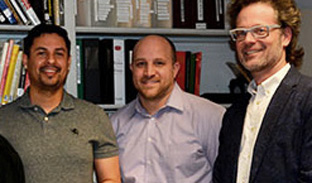
Members of the Molecular Archeology Group, from left to right: Jesse Dabney, Charles Konsitzke, and William Aylward. Photo courtesy of Karen Burch and the Wisconsin Veterans Museum.
A big boost for the group early on was an interdisciplinary grant awarded to Aylward and Sussman through an annual UW Graduate School competition. The money allowed them to develop a specialized Ancient DNA Extraction Facility within the UWBC, as well as hire Dr. Jesse Dabney, a young post-doctoral fellow. Dabney had trained at the Max Planck Institute in the lab of Dr. Svantee Pääbo, the world’s leading archeogenomicist who received much attention for sequencing the Neanderthal genome. Dabney’s own thesis research made him well suited to tackle the ancient DNA extraction challenges that awaited him at the University of Wisconsin. The group is unanimous in their belief that if Jesse himself could be “cloned,” they’d all benefit greatly.
With its own designated space on the second floor of the UWBC, MAG meets twice a month to discuss new projects and provide updates about ongoing projects. The seed for a new project often begins with archeological findings. Says Aylward, “There are amazing archeological collections all over the world. They tell so much about our ancient past, and so many research questions develop around these.”
Precious collections from Anatolia
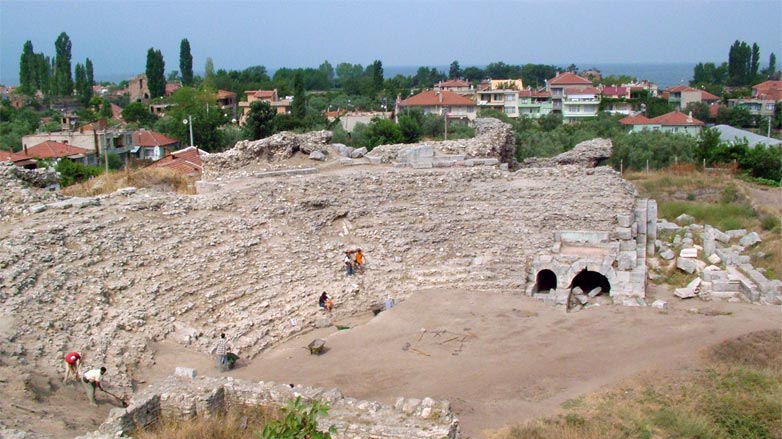
Excavations in the Roman Period theater at ancient Nicea (modern day Iznik) in Turkey. Photo courtesy of Hacettepe University.
The archeological collections that have landed on the lab benches at MAG’s headquarters represent a wealth of information; they include skeletal remains excavated from sites in Turkey, in the region of Anatolia. The opportunity to study these sacred specimens arose when the group hosted a colleague from Hacettepe University in Turkey—a physical anthropologist who has studied ancient civilizations for the past 30 years. The collaboration has since provided MAG the opportunity to participate in the excavation and curation of large collections of human skeletal remains, a project that spans 10,000 years and numerous archeological sites.
The region of Anatolia is particularly fascinating to anthropologists because it is, in essence, considered to be the crossroads of civilization. Situated between the Middle East and Africa, it serves as a bridge between continents and represented a true pass-through point for populations as they moved across regions.
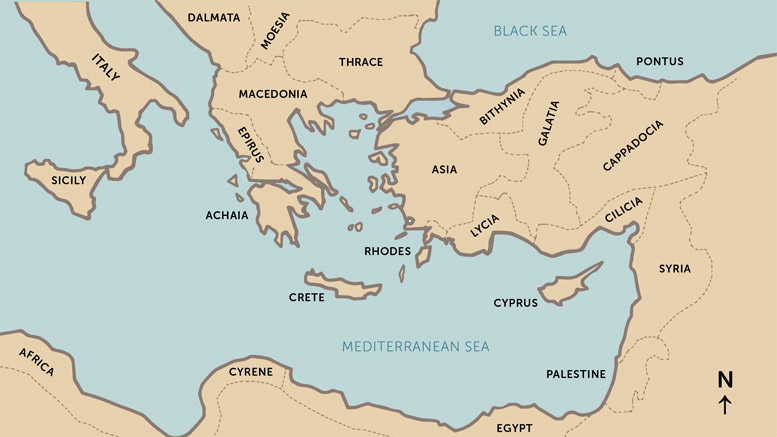
Map of the region of Anatolia where valuable collections of ancient artifacts have been uncovered.
“By partnering with our colleagues in Turkey we can ask questions that require taking those specimens and examining ancient DNA. Then, we can use those results to create a more detailed picture of life and death in antiquity,” explains Aylward. “These collections hold the key to questions about early civilization.”
These collections hold the key to questions about early civilization.
Excavation of these materials is followed by morphological analyses of the human bones uncovered; this in turn reveals critical information including gender, age and dating of the time of death. With this knowledge in hand the MAG team then seeks to take a deeper look, often at the microbial level, for evidence of disease.
“The overall goal of this collaboration and our initiative is to use information from the past to inform the present and the future,” explains Aylward. “Knowing about the origins of a particular pathogen, for example, can inform our interaction with that pathogen and perhaps help us to do a better job of preventing future spread of related pathogens.”
The interest in such projects may have been easy to generate, but as for handling of the samples themselves, that is a different story. When working with artifacts and bones ranging in age from 700 to 7000 years old, the extraction and sequencing of DNA that ancient is not a trivial task.
Sophisticated technology required
That is where Dabney’s expertise kicks in. His ability to extract DNA from precious samples has moved many projects forward, and while he works primarily with bone and teeth samples, he has also applied the technology to more esoteric DNA sources such as the feather of a bird.
As Dabney explains, each project begins by assessing the type and the condition of the sample he is tasked with analyzing. Step one is to don the necessary attire for working in the “clean room” of the DNA extraction facility—a necessary precaution to guard against the very high risk of contamination by other DNA.
Beginning with the rather rudimentary steps of DNA extraction he puts a drill to the sample, a drill he describes as similar to the type dentists use when working on our teeth. “You don’t need too much [bone powder] – I usually try to get 10-100 mg total,” he says. After collecting the powder, he dissolves it in a buffer solution that releases the DNA. Dabney is modest in describing his role in the critical step of recovering clean and workable DNA from ancient samples, but in truth, a great amount of work and troubleshooting was spent developing and optimizing the protocols needed for successful DNA extraction.
After DNA purification the sample is ready for any of a variety of protocols including the creation of a DNA sequencing library, PCR (polymerase chain reaction), and Next Generation Sequencing. Dabney regularly uses Promega chemicals for sample preparation and the Quantus™ Fluorometer for quantifying DNA samples.
Before a DNA sample is ready to be sequenced, there are important options to consider, depending on the objective of the project. “Shotgun sequencing” of the sample is one approach; as Dabney explains, “in these cases we sequence all the DNA to see what we get. This serves as an initial round of screening to assess the status of the DNA and how well it’s been preserved.”
Extracting DNA from the feathers of a symbolic eagle
MAG was recently called on to solve a century-old scientific mystery regarding the gender of Old Abe, Wisconsin’s celebrated war eagle who served as a mascot of the Civil War. Three feathers collected from the bald eagle ended up in the Wisconsin Veteran Museum archives, and when the question of Old Abe’s gender arose several years ago, staff members realized that perhaps DNA could be extracted from the feathers. A novel challenge for Jesse Dabney, he succeeded in extracting the bird’s DNA and determining that Old Abe is indeed a male.
Another approach is to first enrich for DNA from a particular species within a given sample. Here, Dabney uses solution capture methods to pull out DNA molecules of interest, allowing him to eliminate what he does not need and instead enrich for what is most important to study. Says Dabney, “it’s a big consideration, which sequencing approach to pursue – shotgun versus enrichment.
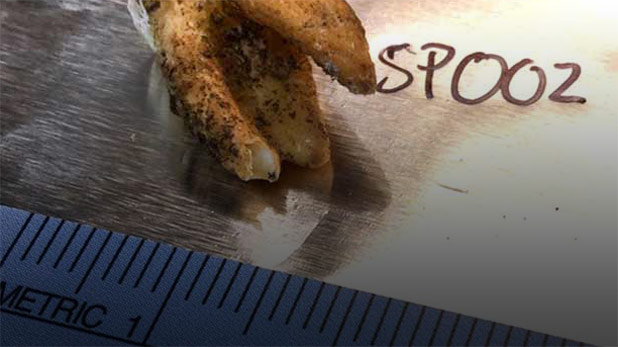
Example of an ancient tooth that serves as starting material for DNA extraction and sequencing in the MAG lab.
The decision is typically influenced by the type of DNA sample in front of him. With human DNA samples enrichment is often the preferred option, and through this protocol he can enrich for mitochondrial DNA which may be more discriminating and provide the most useful sequence information. Bacterial DNA samples on the other hand are often comprised of many different types of bacterial DNA. A shotgun approach therefore provides a general sense of what’s available to analyze and which samples are best preserve and more likely to yield DNA sequence results.
Not surprisingly, Dabney’s work is time-consuming; at a minimum it takes upward of three weeks from the time he collects bone powder to the time he has some useful DNA sequence. And with DNA sequence finally in hand the next phase involves computational analysis, which is just as critical and laborious as the steps that preceded it.
“Computational analysis is a much more hands-on component of what we do, and it involves a tremendous amount of programming and software,” says Dabney. Depending on the platform, there can be millions to billions of molecules to analyze. The ultimate goal is to be able to align the DNA sequence he’s just recovered to a genome of interest. The bigger question for molecular archeological analyses is to identify from what population a recovered sample belongs, or how it fits within the genetic context of its surrounding. These answers can help determine human migration patterns, or the evolution of a particular pathogen.
Bountiful collections and a bounty of projects
With the accessibility of valuable skeletal collections excavated from ruins in Anatolia, MAG’s initial research strategy was to cast a wide net and search for any evidence of a previously living organism within an archeological site. This proved to be a productive time as they reeled in many interesting projects. The ones that bubbled up to the surface were those that involved pathogen DNA, and with that, new collaborations formed.
For example, work with Dr. Caitlin Pepperell, Professor of Medical Microbiology at UW-Madison, has been a fruitful partnership. As an infectious diseases physician, microbiologist and evolutionary biologist, she has always been fascinated by the study of the evolution of pathogens. The origins of the specimens she analyzes, with the help of MAG, is valuable in terms of what they can reveal. The high population density in the Anatolian cities resulted in a faster rate of evolution, transformation and transmission of disease. So, one long-term goal of this collaboration is to develop a profile for the emergence and evolution of disease in the some of the world’s first cities.
But first, Pepperell is working closely with Dabney to help place the ancient DNA data he obtains into context. After analyzing the raw sequencing data they must decide if what they’ve recovered is “bona fide ancient DNA,” rather than contaminants. “This is a very involved process,” she says. “We are trying to first eliminate junk and turn huge data files into workable sizes.”
Once Pepperell has material to work with she tries to answer the question: What do you do with the data and how do you interpret the evolutionary aspects of this? The analysis at this stage becomes computational. “Essentially what you’re doing is analyzing mathematical models for how sequences are related and how they change over time,” says Pepperell. “We hope to use these data to reconstruct the evolution of a particular population or the migration pattern of a certain pathogen.
Other projects that have filled MAG’s plate showcase the unique expertise the group is able to apply, combined with the wealth of research interests of their collaborators. When certain samples recovered from the sites in Anatolia showed evidence of leprosy, MAG initiated a collaboration with the skin disease research center at the University of Wisconsin to study those samples more in depth.
Another exciting project currently underway is the recovery of a P47 fighter plane that went missing in France in World War II. This summer a group traveled to France for three weeks as part of the Missing in Action Recovery and Identification Project to embark in the recovery mission of the WWII pilot who went down with his plane. The project includes members of the U.S. Department of Defense (DOD), UW-Madison and University of Hawai’i-West O’ahu students, via a collaboration between the two institutions. The mission was led by Dr. Leslie Eisenberg, Honorary Fellow in the UW-Madison Anthropology Department and Dr. William Belcher, a University of Hawai’i-West O’ahu archeology professor and DOD lead forensic anthropologist within the Defense POW/MIA Accounting Agency. “This represents a way in which the federal government is now partnering with universities for identifying MIAs,” explains Aylward. “This is a big step forward to address the existing backlog at federal level, and we are here to help them.”
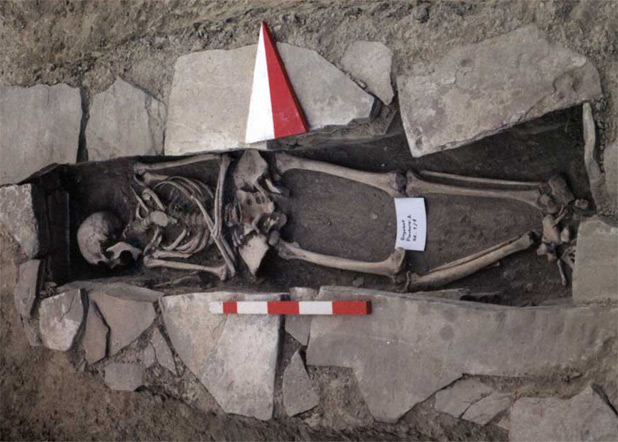
A grave of the Late Byzantine period (~1200 A.D.) from a cemetery discovered at Kovuklukaya, in Turkey, near the Black Sea coast. Photo courtesy of Hacettepe University.
MAG as a model for others
The MAG group and its objectives are a newer concept for the University of Wisconsin and for American universities in general; more common in Europe, initiatives of this kind are now developing around the world. In all cases, they involve the merging of different fields of studies and continue to be highly interdisciplinary. Like UW’s MAG, these groups represent a more holistic concept of scientific and archeological research and derive results by relying on a variety of disciplines.
Aylward’s role in creating MAG and the wealth of information he’s gaining through his interaction with his colleagues has led to his development of a popular introductory course, Molecular Archeology, offered exclusively to University freshmen. The goal is to excite students about the possibilities of marrying archeology with molecular techniques and let them discover the many paths that such an exploration can lead them down.
“This group and its efforts represent a key bridge between science and humanity, and the answers we uncover can have an impact on humanity,” he says. “There is historical relevance here, and these archeological reserves are gold mines of scientific information just waiting to be extracted and interpreted.”